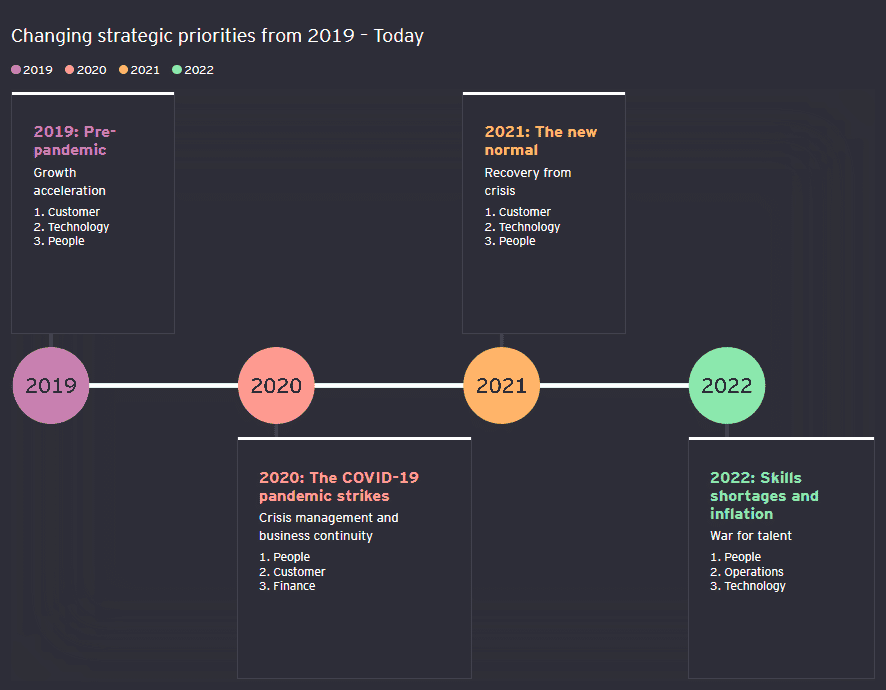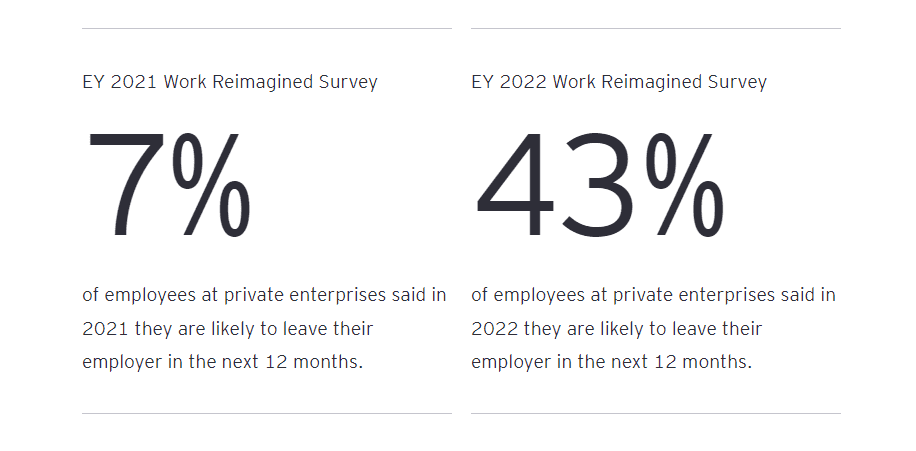With ongoing volatility comes opportunity for those business leaders who manage to focus on critical success factors for long-term success.
In brief
- Over the past three years, the strategic priorities of entrepreneurial businesses have dramatically shifted back and forth across four distinct phases.
- Leading organizations amidst these volatile times are defined by three success factors.
- The businesses that prosper in challenging times are guided by their purpose and focus on creating long-term value for stakeholders.
A series of major economic, geopolitical, health and climate events have recently caused tremendous disruption to businesses. Whereas a company’s strategy would once have given clear direction for a good number of years, the past three years have required business leaders to adapt their company strategies on multiple occasions.
EY research into more than 3,000 strategic growth plans created by privately owned entrepreneurial businesses around the world shows how their strategic priorities have changed since 2019. These changes have taken place in four distinct phases.

The timeline shows how the strategic priorities for entrepreneurial business leaders have changed from 2019 to 2022.
Phase 1 (Pre-pandemic): Growth acceleration
Back in 2019, the general focus of entrepreneurial business leaders was on accelerating growth. Accordingly, the research found that the following were then the top three key strategic priorities for entrepreneurial businesses, in the following order:
- Customer: Entrepreneurial businesses sought to enhance the experience across the full customer journey with their business. This involved a strong focus on product and service innovation.
- Technology: By adopting new technologies (such as artificial intelligence) and improving their data and analytics capabilities, entrepreneurial businesses aimed to enhance the digital customer experience to meet changing customer demands.
- People: To implement technological changes and achieve digital transformation, entrepreneurial businesses needed to build new internal skillsets and competencies. This led them to focus on recruitment, upskilling the workforce and developing the leadership team itself.
Phase 2 (The COVID-19 pandemic strikes): Crisis management and business continuity
The COVID-19 pandemic hit in 2020, plunging many countries into an economic recession. This forced business priorities to change. Most businesses shifted their focus from growth to crisis management and business continuity, followed by recovery. The top three priorities for entrepreneurial businesses during 2020 were:
- People: Entrepreneurial businesses prioritized the health and wellbeing of their people and workforce.
- Customer: As businesses faced a sudden drop in demand, they emphasized customer retention and loyalty, as well as brand protection.
- Finance: To secure continuity, businesses immediately focused on liquidity and cash flow management. Where possible, and where necessary, this included making use of government grants and incentive schemes.
Phase 3 (The new normal): Recovery from crisis
A new normal slowly emerged in 2021. In addition to creating new ways of working, the pandemic had shifted customer buying patterns and expectations. Supply chain disruption resulted in delivery issues, scarcity of resources, higher costs, and increased purchase prices for consumers.
Those businesses that were able to adapt quickly to the changing circumstances identified significant opportunities for growth. Hence, they swiftly re-focused from business continuity to bouncing back from the global health and economic crisis in pursuit of accelerated growth.
The businesses that thrived in 2021 shifted their top three priorities back to the same priorities they had had in 2019, namely:
- Customer: Businesses redesigned their ”customer journeys”, often moving to digital channels. They optimized all touchpoints on these journeys while seeking to manage the holistic customer experience. Additionally, they invested in product and service innovation to meet new customer demands and embarked on innovative partnerships, strategic alliances or M&A deals to quickly respond to changing customer needs.
- Technology: Many of the changes on customer journeys needed to be technology-enabled, leading businesses to adopt new technologies and data analytics capabilities.
- People: Demand for digital competencies and skill sets led to a shortage of talent. Besides an increased focus on recruitment, this caused a strong focus on upskilling the workforce to build up new skillsets and competencies.
Phase 4 (Skills shortages and inflation): Seizing opportunities while bracing for a recession

New economic and geopolitical developments began to significantly impact business decision-making in 2022. Furthermore, employers face an ongoing skills shortage that shows no sign of abating quickly. The EY 2022 Work Reimagined Survey found that nearly half (43%) of employees at private enterprises say they are likely to leave their employer in the next 12 months. This represents a significant rise from 2021, when just 7% said they’d be unlikely to stay.
In addition, the war in Ukraine has caused an unparalleled energy crisis and generally exacerbated price rises across the globe. To control inflation, central banks are raising interest rates, increasing the cost of capital for businesses.
These developments – combined with ongoing uncertainty over how they will play out – have caused yet another change in business priorities. Today entrepreneurial businesses have once again shifted their top three priorities to:
- People: Businesses want to manage their talent shortages and retention rates. They are therefore focused on recruitment and employer branding, strategic workforce planning, talent development programs, total reward packages and critical succession planning.
- Operations: The pressure on margins is leading businesses to prioritize cost-saving programs. These programs aim to reduce the cost of goods sold and the cost of capital, increase efficiency and productivity levels, improve supply chain management, boost working capital, digitalize processes, enhance forecasting, and review pricing strategies.
- Technology: Technology adoption is helping to drive down costs by further automating and digitalizing work processes while improving customer engagement and journeys. Businesses are making ongoing investments in data analytics capabilities and cyber security.
Factors for Success
There is no end in sight to the ongoing economic, geopolitical, health and climate challenges we face. Nevertheless, the past few years have made one thing abundantly clear: uncertainty and change are the new constants.
So, how can businesses define the right course of action amid all the uncertainties they face? Three key success factors stand out:
1. Building resilience
Resilience starts with visibility. So, leading organizations are establishing digitalized, real-time, and end-to-end visibility of their supply and value chains, which also enables them to simulate different types of disruptions. They are reconsidering their supply chain architecture (the number and location of sites and facilities, investments and divestments), and are moving from linear supply chains to integrated ecosystems and networks. They are also exploring how they can insource key functions while smartly outsourcing others to build a more agile organization. Furthermore, as EY research The CEO Imperative: How mastering ecosystems transforms performance shows, leading companies are making ecosystem business models a strategic imperative. Those who exhibit leading practices in their management and execution of ecosystem business models outperform those that do not in terms of incremental revenue growth and earnings as well as cost reduction. And 91% of CEOs surveyed agree that ecosystems have increased the resilience of their business. Additionally, leading organizations are building a resilient and flexible workforce that can adapt to new ways of working. The culture of this workforce is one where “failing quickly” is encouraged, as is taking on board learnings from past experiences to drive continuous improvement and adaptability.
2. Scenario planning
Resilience is not just about the ability to respond quickly and effectively to disruption and unexpected events. It’s as much about thinking ahead, planning for what might be coming, and being prepared. Leading companies have therefore adopted scenario analysis and planning – the systematic exploration of multiple plausible futures. EY Geostrategic Business Group analyzed current geopolitics to explore what scenarios are likely to emerge in the next five years and how those would impact businesses. This analysis is a good place to start for companies looking to embark on scenario planning.
3. Balancing capabilities across seven key drivers of growth
EY research into the growth journeys of more than 1,000 market-leading companies has shown that achieving accelerated and sustainable growth over the years requires a company’s maturity to be balanced across seven critical drivers: Customer, People, Technology, Operations, Finance, Transactions and Risk.
The research highlights that imbalances in capability maturity will lead to growing pains and setbacks sooner rather than later since the growth drivers are all interconnected. Those businesses that manage to maintain a balance of maturity across these seven drivers of growth tend to grow more sustainably.
Long-Term Strategic View
In summary, the last three years have brought four major swings in terms of the strategic priorities of entrepreneurial business leaders. Yet while companies have understandably needed to react to sudden and unexpected disruptions to manage their short-term performance, these responses will not necessarily support the mid- to long-term success of the business.
Unfortunately, sudden and dramatic swings in priorities tend to cause imbalances. These imbalances then need to be addressed to drive sustainable growth over the longer term. History has shown that the businesses that are most successful at weathering storms take a steady approach to strategy, are purpose-driven, and remain focused on long-term value creation for all their stakeholders.
The article was first published here.
Photo by Gabriel Valdez on Unsplash.

 5.0
5.0 




















